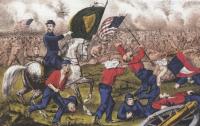Irish Yankees
Published in 18th–19th - Century History, Features, Irish Republican Brotherhood / Fenians, Issue 5 (Sept/Oct 2012), Volume 20
Col. Michael Corcoran, born in Carrowkeel, Co. Sligo, in 1827. He emigrated to New York in 1849, quickly becoming embroiled in Irish-American political intrigues. Well known at Hibernian Hall on Prince Street where the IRB foregathered, he was a Tammany Hall operator relied upon to deliver the Irish vote. Prominent in the 69th, he achieved notoriety by refusing to parade the regiment before the prince of Wales in 1860. He avoided court-martial for insubordination when Lincoln called for troops to defend the Union on 15 April 1861 and the charge was dropped. He fought at the First Bull Run (July 1861), where the Irish Brigade suffered over 200 casualties. During a skirmish he was captured and became a prominent Confederate hostage to ensure the good treatment of its prisoners. Released in an exchange programme, he returned to New York to recruit a fresh regiment, which became known as ‘Corcoran’s Irish Legion’. A confidant of Lincoln, he took part in the defence of Washington, overseeing the building of Fort Corcoran. He died in a riding accident in Virginia in December 1863. (Currier & Ives)
Union leaders were initially reluctant to establish ethnically based units but were soon swayed by the attractions of enhanced Irish recruitment to a brigade with its own Irish commanders. Significantly, Irish involvement meant the acceptance—for the first time in American life—of a large Catholic force. The brigade’s chief chaplain, Fr William Corby (later president of Notre Dame University, Indiana), became famous for administering absolution at Gettysburg.The secretary of war, Simon Cameron, authorised the brigade’s formation in September 1861; it consisted initially of three New York infantry regiments—the 63rd, 69th and 88th. Its commanders and rank-and-file had known Fenian connections. It was quickly joined by the mainly Scots-Irish 29th Massachussets regiment. The alliance withstood ancient animosities and earned plaudits for hard campaigning during the Seven Days Battles (June 1862), notably at Savage’s Station, Glendale and Malvern Hill. Later, the New Englanders were replaced by a wholly Irish regiment from Philadelphia, the 116th.The brigade distinguished itself throughout the conflict but with increasing casualties. By June 1864 it was reduced to almost regimental size. When its last prestigious commander, Col. Richard Byrne, fell, its remnants were incorporated into the 3rd and 4th Brigades, 1st Division Corps. Officially designated the ‘Fighting 69th’, it continued to serve. Sections of the brigade still participate in New York’s St Patrick’s Day parade.
















